I have been baking fabulous breads with Dirk, my rye sour, from pure rye flour as well as mixed breads from rye with wheat or oats for years. I can't complain about a lack of diversity. However, I like pizza or rolls best of all from pure wheat. Unfortunately, quick wheat breads made from flour and baker's yeast are not so well tolerated.
A dilemma? But no. A wheat sourdough is needed!
And what better way than with the much vaunted Italian mother yeast. Mother yeast aka Lievito Madre is an easy to make, solid wheat sourdough with extremely strong baking properties.
The wild yeasts and bacteria present in wheat flour are, however, unlike the rye sour, not quite sufficient to give the Lievito Madre enough driving force and therefore need support from a wild yeast-based water. You can easily make this yeast water yourself from an apple and water. You can also use any other starter culture instead, such as kombucha or whey from milk kefir. I like the yeast water from apple best, because the sweetish aroma underlines the Lievito Madre nicely.
INGREDIENTS yeast water
- 1 regional organic apple
- approx. 250ml water
You will also need a glass jar of approx. 750 ml with a lid, which should be higher than wide. The most suitable jar is a drop jar, e.g. from Weck.
PREPARATION yeast water
Cut the apple with the peel into rough pieces and cover it with water in the jar. The wild yeasts on the peel are needed for the fermentation process, so it is important that you do not wash off the yeasts, so take an organic apple. Fix the cloth on the jar with the rubber band to keep small critters away from your yeast water. Stir several times a day to keep the rising apple wetted with water and prevent it from becoming moldy. The goal is for the water to become yeasty. This takes 2-3 days and you will recognize success by the sweet and slightly alcoholic smell. At the slightest traces of mold, you dispose of everything and start over. This type of mold is toxic and must be avoided at all costs.
The yeast water is your starter culture, with which you now inoculate the wheat flour.
INGREDIENTS Lievito Madre
- approx. 75 gr. yeast water
- all-purpose wheat flour
PREPARATION Lievito Madre
The most important thing with sourdough is to give it a name so that it works. My Lievito Madre is called Frau Fadiga.
After the naming mix 120 gr. wheat flour and 75 gr. yeast water until a not too liquid dough forms. If you know rye sour, the dough will seem much too solid, but do not be put off, it is meant to be. To get your Lievito Madre warm enough to get going, it's best to put it in the oven and leave the light on. The lid is set loose on the jar.
The next day, the volume of the starter should have approximately doubled and nice bubbles should be visible in the dough. The consistency is tough and rubbery. From now on, refresh your Livieto Madre once a day, preferably always at about the same time. For this you mix
- 80 gr. starter (leavening)
- 80 gr. all-purpose wheat flour
- 50 gr. lukewarm water
Afterwards, put the jar back in the oven. After 3-4 days, your Lievito Madre should come off really well, so that it no longer needs to be warm in the stove, but can tolerate normal room temperature. Also, it no longer takes 24 hours for the volume to double, but rather 4-5 hours.

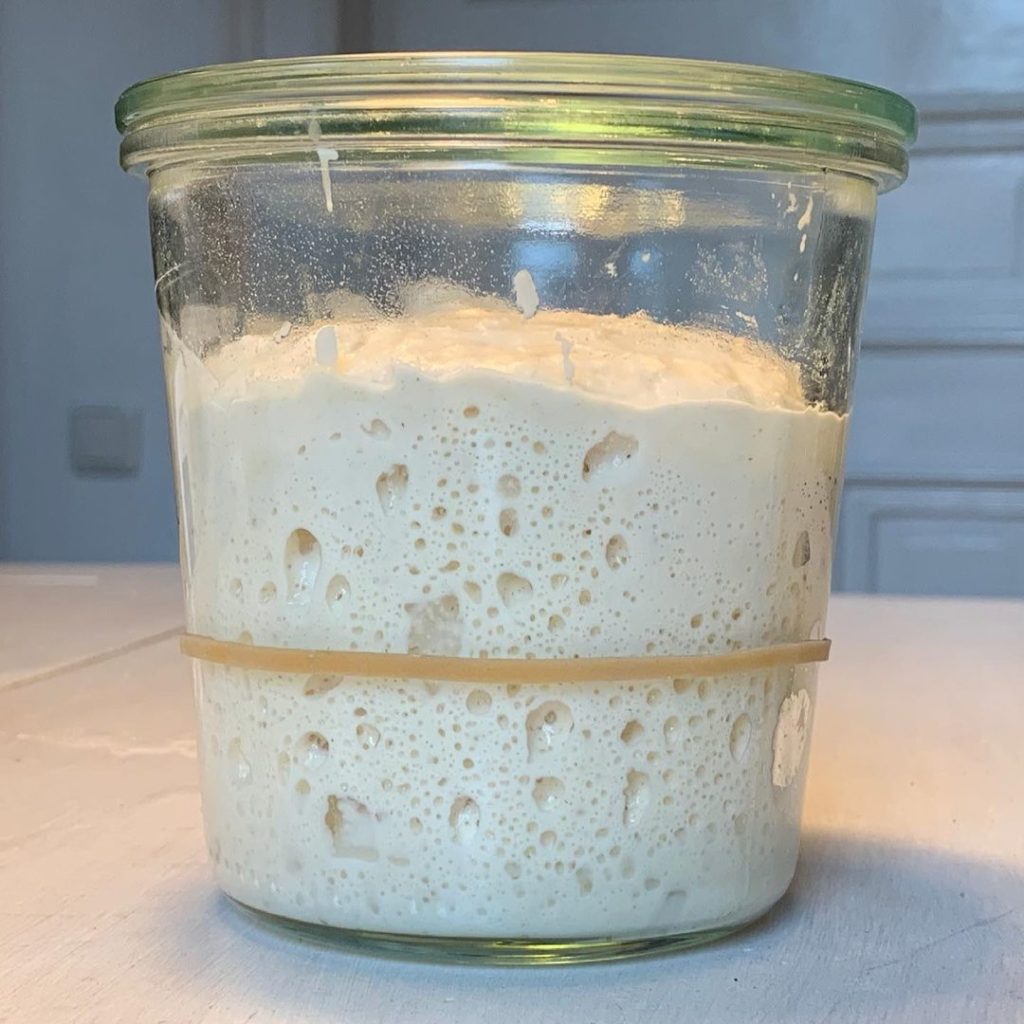
How to store and maintain Lievito Madre?
The Lievito Madre can be stored in a jar with a loose lid in the refrigerator between baking. Particularly suitable for this purpose are drop jars with the lid on, without seal. It will keep in the refrigerator for about a week. After that you need to refresh it again. This means that you have to mix 80 gr. of the starter with 80 gr. of wheat flour and 50 gr. of lukewarm water in a fresh jar. Put the lid on the jar and let the starter rise at room temperature for 8-10 hours, until the volume of the dough has increased significantly. When refreshing, the batch does not need to be as warm as when it was first made. When your Lievito Madre has risen and you can see many bubbles in the dough, you can put it back in the refrigerator for storage.
Before you bake a bread, you need a strong, active starter. So it makes sense to have refreshed the Lievito Madre beforehand.
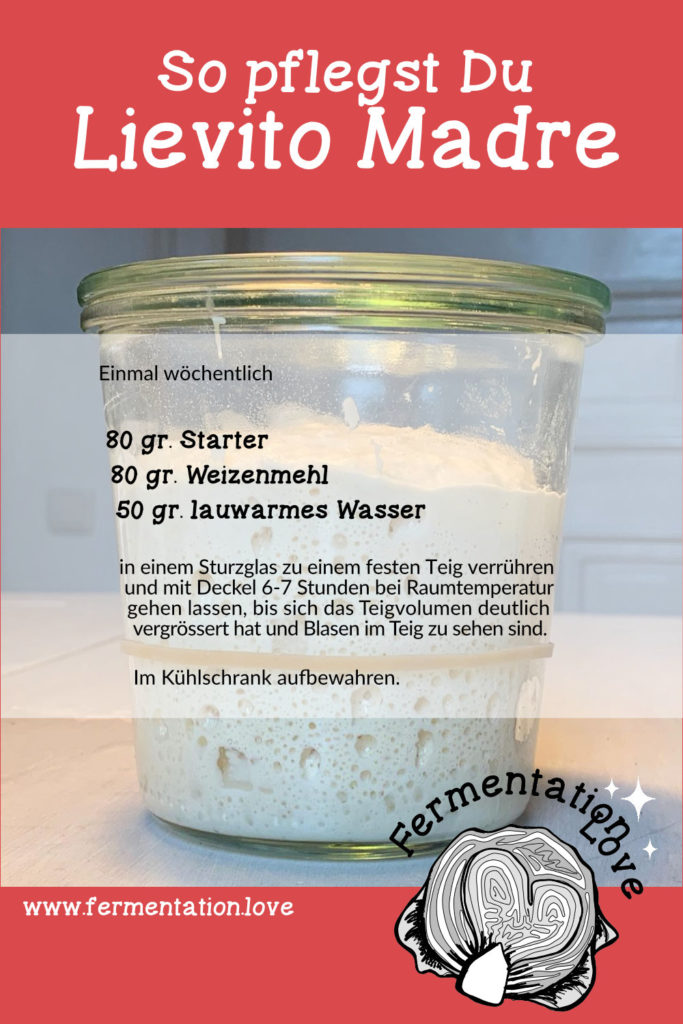


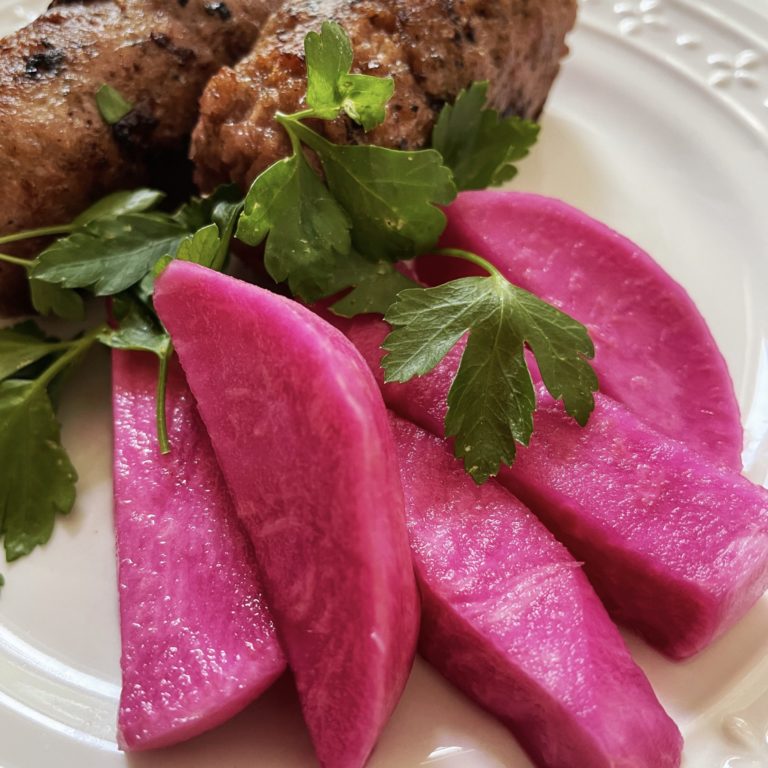
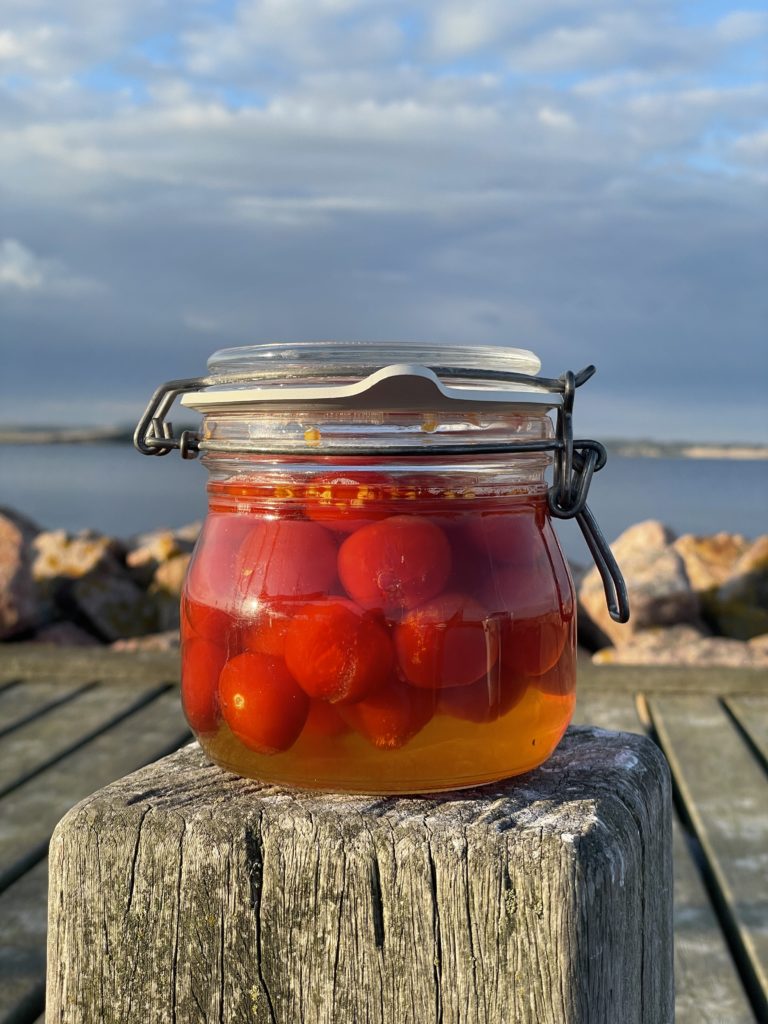
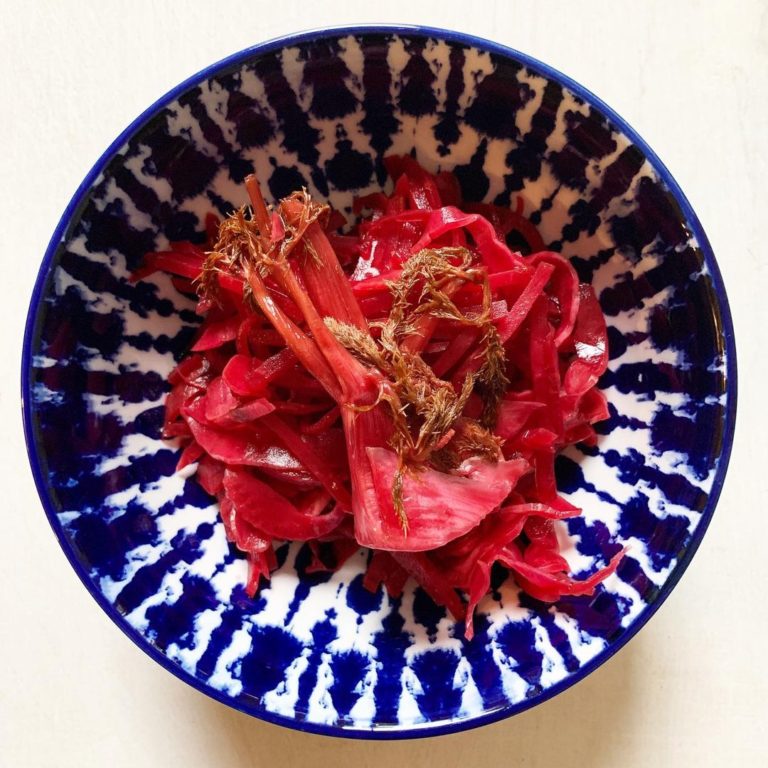
Was machst du mit dem
Rest von dem Starter wenn du nur 80 Gramm davon verwendest?
Liebe Rebecca,
mit Sauerteigresten kann man ganz viele Dinge machen! Ich benutze den übrigen Teig gerne in Pfannkuchen oder Waffeln, oder backe ein schnelles Brot mit zusätzlicher Hefe. Manchmal benutze ich es als Starthilfe für fermentiertes Obst oder Getränke.
Gib einfach Sauerteig Reste oder Sourdough Discard in eine Suchmaschine ein, Du wirst etliche Treffer bekommen.
Viele Grüße,
Katsu
Hallo. Mein dörk blubbert vor sich hin. Meine Frage bezieht sich auf das ansetzen bzw wenn ich Teig angesetzt habe, soll ich ja 80 g starter nehmen und 80 g Mehl und 50 g Wasser zugeben. Aber ich hab ja viel mehr starter als 80g wenn ich nach deinem rezept beim zb 4. Tag lande. Was mach ich mit dem Rest?
Hej Nadine,
ich gebe den überschüssigen Teig in das Gebäck, was an dem Tag ansteht. Kekse, Pfannkuchen, Schnecken, Brötchen, salzige Teilchen… und wenn nichts ansteht, denke ich mir spontan was aus. Die Kolleg:innen lieben meine „der Sauerteig musste weg“ Backtage 😉
Viel Spaß beim Backen!
Katsu
Hallo Katsu,
ich habe Fragen zum Hefewasser: wie seihst du das Hefewasser ab, einfach durch ein Sieb? Wie lange kann man das im Kühlschrank aufbewahren? Oder für etwas anderes nutzen?
Und eine Frage zum Mehl: ich bekomme hier Weizenmehl 450 oder 550. 505 habe ich nirgends gesehen, jedenfalls nicht in Bio. Geht 550 auch?
Vielen lieben Dank!
Übrigens wird mein Kefir immer besser – vielleicht auch, weil ich ihm nun angeregt von dieser Seite einen Namen gegeben habe? Er heißt Karl der Kefir 🙂
Beste Grüße
Anke
Hej Anke,
ich seihe die Früchte einfach durch ein Sieb ab. Dann hält das Hefewasser auch sehr lange im Kühlschrank, sicher 2 Monate. Und ja, Mehl kannst Du auch anderes helles Weizenmehl benutzen.
Den Namen Deines Kefirs liebe ich sehr – einer meiner Söhne heisst Karl, genannt der Käfer 🥰
Herzliche Grüße,
Katszu
Liebe Katsu,
vielen Dank für Deine schnelle Antwort! Jetzt habe ich noch eine Frage zum Hefewasser. Ich habe auf verschiedenen Brotbackseiten gesehen, dass man nur mit Hefewasser backen kann – da wird das Hefewasser aber tägl. geschüttelt. Hast Du damit auch Erfahrung, oder vielleicht auch ein leckeres Rezept?
Schönen Abend noch!
Hej Anke,
gelesen habe ich das auch, aber probiert noch nicht. Ich nutze wirklich fast ausschließlich meine diversen Sauerteige zum Backen.
Herzliche Grüße,
Katsu
Hallo Katsu
Sehr interessant, das möchte ich gerne ausprobieren. Ich bin jedoch nicht sicher, 80 gr. Grundsauer (Starter, Anstellgut), das muss man kaufen oder separat erstellen oder ist dies das Ergebnis vom 1. Schritt mit 75g Hefewasser und 120 gr Weizenmehl? Vielen Dank für deine Hilfe und ♥️-zliche Grüße Angela
Hej Angela,
genau richtig, das ist das Ergebnis des ersten Schrittes.
Gutes Gelingen!
Katsu
Hallo Katsu,
ich habe meine ersten Experimente mit Brötchen und Brot hinter mir! Es ist nicht alles optimal gelaufen, bis ich gemerkt habe, das meine Unterhitze nicht mehr geht. Bin dann auf das Backfach vom Holzbackofen ausgewichen, damit habe ich aber noch nicht viel Erfahrung.
Jetzt geht es in die nächste Runde und ich wollte mal anfragen, ob Du uns ein Brot- und ein Pizzateigrezpt mit Lievito Madra einstellen magst? Ich fühle mich noch etwas unsicher, wie ich meine tolle „Olga“ jetzt verwenden kann.
Dank und liebe Grüße in den Norden!
Hej Anke,
klar, das kann ich mal machen.
Liebe Grüsse!
Katsu
Hallo liebe Katsu , heute früh habe ich nach feierlicher Namensgebung , sie heißt „Mamma Sophia“, meine Lievito Madre mit dem zuvor gemachten Hefewasser angesetzt , jetzt steht sie mit eingeschaltetem Licht im Backofen , könnte sie auch einfach so in der Küche stehen wie “ Kai-Uwe“ mein Sauerteigstarter , der steht bei etwa 25° auf der Arbeitsfläche ? . LG Anita
Hej Anita, ja, wenn es so warm ist geht das. Gutes Gelingen!